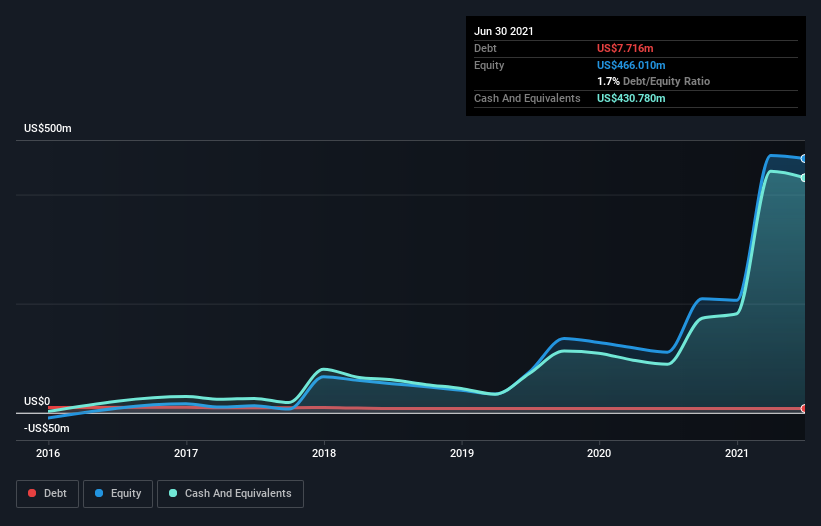Does Quanterix (NASDAQ:QTRX) Have A Healthy Balance Sheet?
Howard Marks put it nicely when he said that, rather than worrying about share price volatility, 'The possibility of permanent loss is the risk I worry about... and every practical investor I know worries about.' So it might be obvious that you need to consider debt, when you think about how risky any given stock is, because too much debt can sink a company. We can see that Quanterix Corporation (NASDAQ:QTRX) does use debt in its business. But is this debt a concern to shareholders?
When Is Debt Dangerous?
Debt and other liabilities become risky for a business when it cannot easily fulfill those obligations, either with free cash flow or by raising capital at an attractive price. If things get really bad, the lenders can take control of the business. However, a more common (but still painful) scenario is that it has to raise new equity capital at a low price, thus permanently diluting shareholders. Having said that, the most common situation is where a company manages its debt reasonably well - and to its own advantage. The first step when considering a company's debt levels is to consider its cash and debt together.
See our latest analysis for Quanterix
How Much Debt Does Quanterix Carry?
As you can see below, Quanterix had US$7.72m of debt, at June 2021, which is about the same as the year before. You can click the chart for greater detail. However, it does have US$430.8m in cash offsetting this, leading to net cash of US$423.1m.
How Healthy Is Quanterix's Balance Sheet?
We can see from the most recent balance sheet that Quanterix had liabilities of US$37.7m falling due within a year, and liabilities of US$24.4m due beyond that. Offsetting this, it had US$430.8m in cash and US$15.4m in receivables that were due within 12 months. So it can boast US$384.2m more liquid assets than total liabilities.
This excess liquidity suggests that Quanterix is taking a careful approach to debt. Given it has easily adequate short term liquidity, we don't think it will have any issues with its lenders. Simply put, the fact that Quanterix has more cash than debt is arguably a good indication that it can manage its debt safely. There's no doubt that we learn most about debt from the balance sheet. But it is future earnings, more than anything, that will determine Quanterix's ability to maintain a healthy balance sheet going forward. So if you're focused on the future you can check out this free report showing analyst profit forecasts.
Over 12 months, Quanterix reported revenue of US$110m, which is a gain of 84%, although it did not report any earnings before interest and tax. Shareholders probably have their fingers crossed that it can grow its way to profits.
So How Risky Is Quanterix?
By their very nature companies that are losing money are more risky than those with a long history of profitability. And in the last year Quanterix had an earnings before interest and tax (EBIT) loss, truth be told. And over the same period it saw negative free cash outflow of US$37m and booked a US$30m accounting loss. But at least it has US$423.1m on the balance sheet to spend on growth, near-term. Quanterix's revenue growth shone bright over the last year, so it may well be in a position to turn a profit in due course. By investing before those profits, shareholders take on more risk in the hope of bigger rewards. When analysing debt levels, the balance sheet is the obvious place to start. But ultimately, every company can contain risks that exist outside of the balance sheet. These risks can be hard to spot. Every company has them, and we've spotted 4 warning signs for Quanterix you should know about.
If you're interested in investing in businesses that can grow profits without the burden of debt, then check out this free list of growing businesses that have net cash on the balance sheet.
This article by Simply Wall St is general in nature. We provide commentary based on historical data and analyst forecasts only using an unbiased methodology and our articles are not intended to be financial advice. It does not constitute a recommendation to buy or sell any stock, and does not take account of your objectives, or your financial situation. We aim to bring you long-term focused analysis driven by fundamental data. Note that our analysis may not factor in the latest price-sensitive company announcements or qualitative material. Simply Wall St has no position in any stocks mentioned.
Have feedback on this article? Concerned about the content? Get in touch with us directly. Alternatively, email editorial-team (at) simplywallst.com.

 Yahoo Finance
Yahoo Finance 
